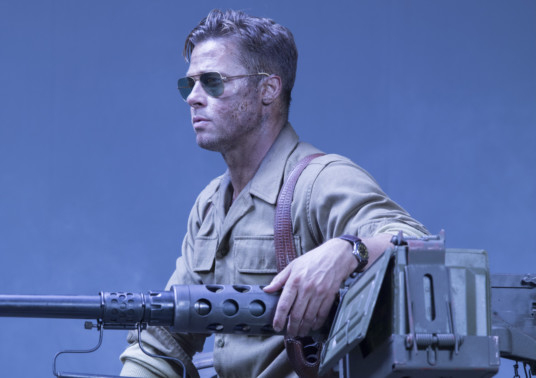
War is hell, and so, to a lesser degree, are war movies. On the set of Fury, which follows an American tank crew through the wreckage of northern Germany in the final days of the Second World War, the actors — among them Brad Pitt and Shia LaBeouf — heckled, strangled and swung punches at each other during filming.
Villagers near the Oxfordshire set were woken in the early hours of Remembrance Sunday last year by the sound of explosions and the sight of SS men swarming the countryside (the director, David Ayer, later apologised for the timing). There were black eyes, bloody noses and bloody mouths, and one unfortunate stuntman, mistaken for a dummy, was bayoneted through the shoulder (he survived).
The five actors who make up the crew of Fury, a Sherman tank — Brad Pitt as Wardaddy, the commander; Shia LaBeouf as the Bible-bashing gunner; Michael Pena, as the driver; Jon Bernthal as the loader; and Logan Lerman as the youngest and greenest member of the team — had already spent weeks together before their first day on set, at a specially tailored boot camp run by ex-Navy Seals.
“We’re just tourists in the war experience,” says Pitt, who looks scarred and menacing on screen, but as crisp as a £50 note off it, sitting in a vast hangar at Bovington Tank Museum in Dorset. “But we were put to a point of exhaustion and no rations and no showers and we were sleeping in the rain, and it was miserable and we loved it.”
As the commander of Fury, Pitt was given slightly better treatment than his men — a separate bunk, for example — and his memories don’t necessarily tally with theirs. “To be honest, I look at the whole process as being pretty dark,” says Bernthal. “I took a year off afterwards,” says 22-year-old Lerman, “because this was a very difficult experience.”
All the same, a sort of pack mentality had set in by the time filming began. “I’ll never forget that first day,” says Bernthal, a classically trained actor and former boxer. “In the screen test, I know it sounds crazy, but people were, like, exposing themselves and fighting. I remember some of the crew saying they were actually scared of us.” This was all the intention of Ayer, the film’s director. Ayer is a military veteran himself, having joined the US Navy when he was 18 and served for two years in a nuclear submarine. That experience inspired him to write his first screenplay, U-571, a film that was attacked in Britain for suggesting that the German Enigma coding machine was captured by an American submarine crew.
In fact, it caused a minor diplomatic incident, with then prime minister Tony Blair calling it an “affront” to British sailors, and Bill Clinton writing a letter of apology for the movie’s inaccuracy.
This time, Ayer was determined to make his story as truthful as possible. “In Second World War dramas there can sometimes be a tendency to mythologise the experience of the soldier and mythologise the nature of the combat. Obviously the enemy was so horrible that we think that the fight itself was black and white, but it wasn’t, just like any war. War is always complex, war is always morally difficult, war forces individuals to make terrible choices.”
— Fury releases in the UAE on October 23











